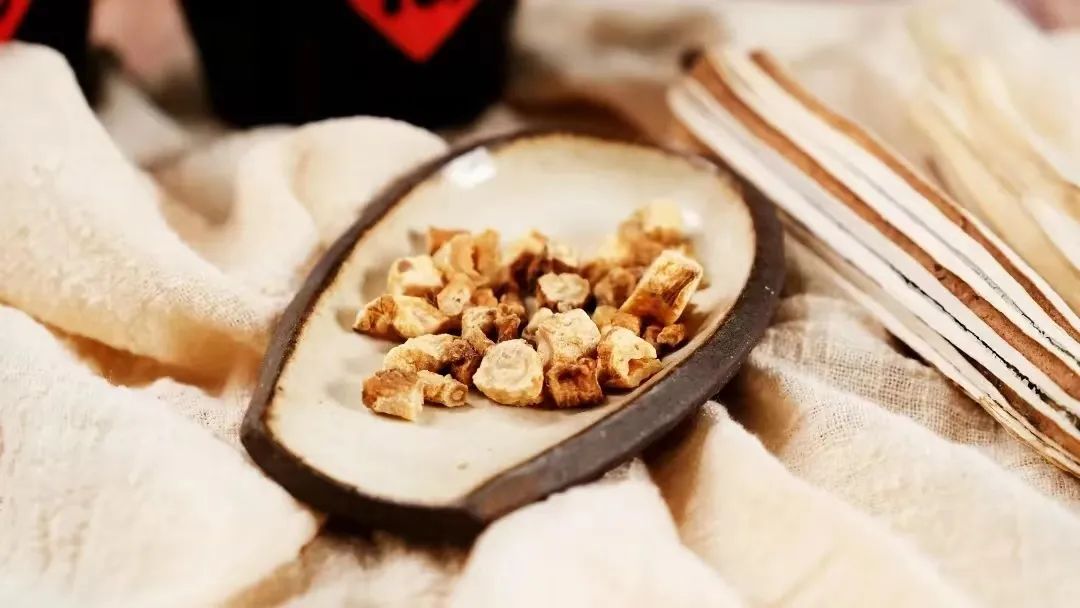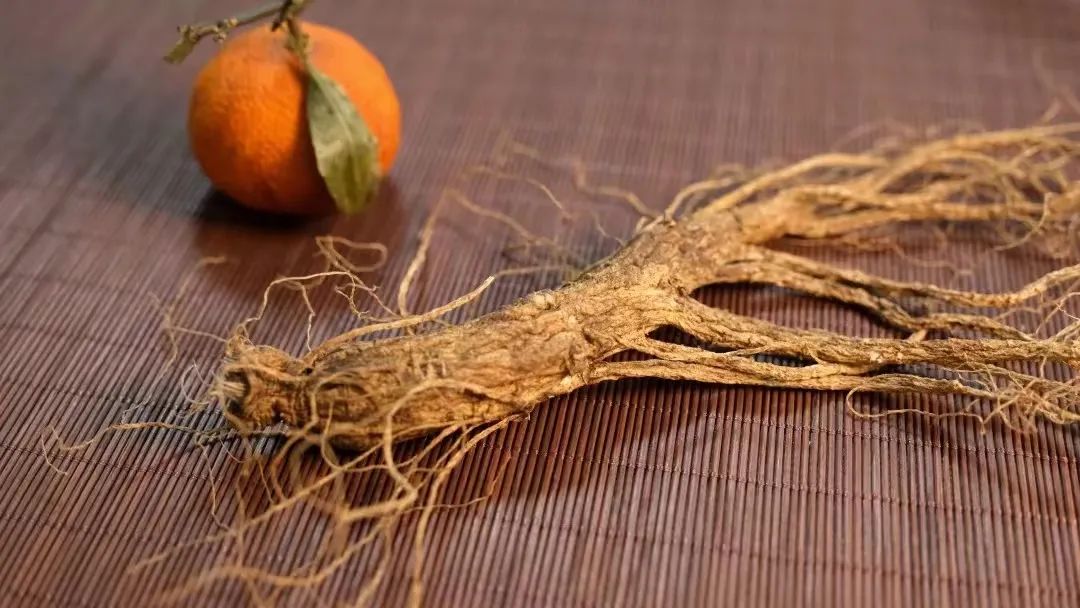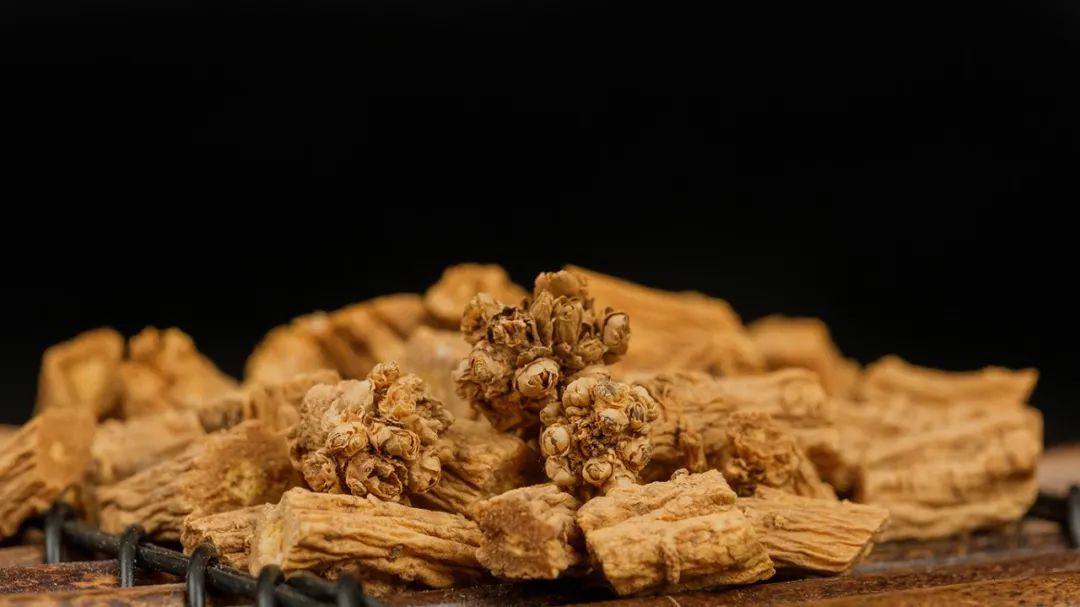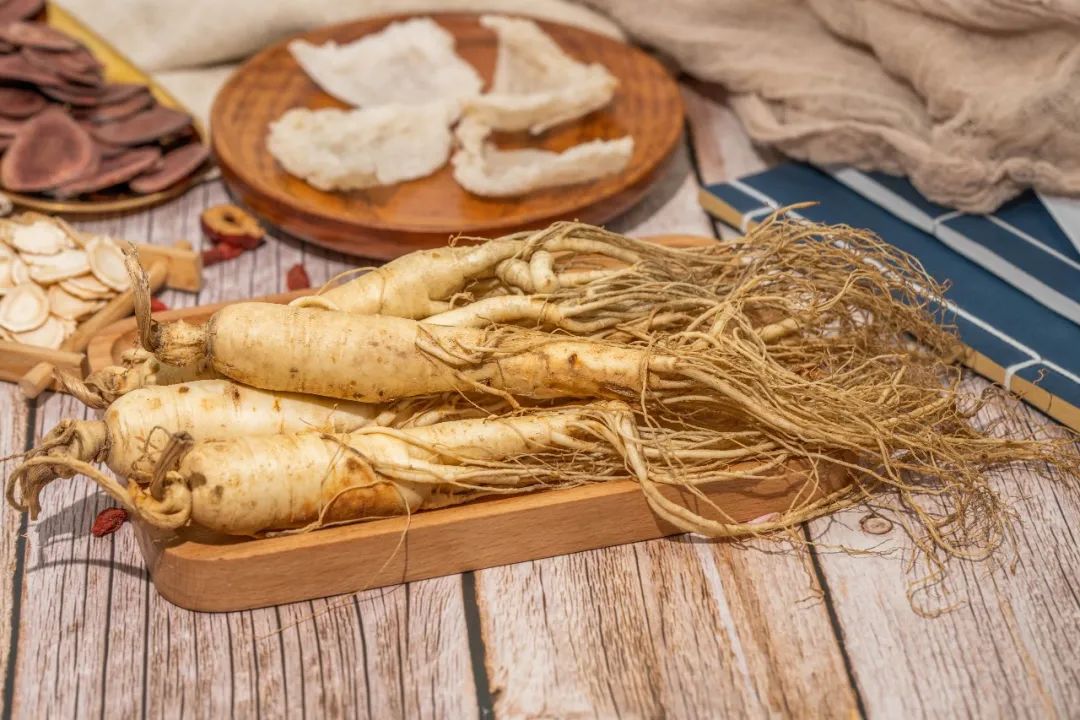
Codonopsis (Dang Shen) is a commonly used herb in Traditional Chinese Medicine (TCM) for tonifying the body. However, if we look at TCM literature, we find that in ancient times, Codonopsis was not used as frequently as it is today. This raises the question: what has changed? What are the differences between Codonopsis and Ginseng? Can they be used interchangeably? Today, we will discuss this topic.

Codonopsis (Dang Shen)
We know that Codonopsis is a plant from the Campanulaceae family, with a sweet taste and neutral nature. It has the functions of tonifying the middle, benefiting Qi, quenching thirst, strengthening the spleen and lungs, nourishing blood, and generating fluids. It is used for symptoms such as spleen and lung Qi deficiency, poor appetite, fatigue, cough with shortness of breath, insufficient Qi and blood, pale complexion, palpitations, shortness of breath, thirst due to fluid damage, internal heat leading to thirst, reluctance to speak, shortness of breath, weakness in the limbs, poor appetite, Qi deficiency, dual deficiency of Qi and fluids, dual deficiency of Qi and blood, and blood deficiency with a pale complexion.

Ginseng (Ren Shen)
On the other hand, Ginseng is a plant from the Araliaceae family, known for its strong ability to tonify Yuan Qi, stabilize collapse, generate fluids, calm the spirit, and enhance intelligence. It is used for symptoms such as shortness of breath, palpitations, excessive thirst and sweating, poor appetite, weakness, and conditions resulting from acute or chronic diseases and blood loss leading to shock or collapse.
Both Ginseng and Codonopsis are Qi tonics, but Ginseng has a stronger medicinal power and is suitable for more severe conditions, even in emergencies. Codonopsis, while also a spleen and Qi tonic, has a milder effect and is more suitable for regular supplementation.
In TCM, Ginseng has been used since ancient times. In Zhang Zhongjing’s “Shang Han Lun,” there are many formulas containing Ginseng. The “Shen Nong Ben Cao Jing” states that Ginseng is “mainly for tonifying the five organs, calming the spirit, stopping palpitations, eliminating evil Qi, brightening the eyes, and enhancing intelligence.” The application of Ginseng has been extensive throughout history. However, there is a question regarding the identification of Ginseng. For instance, is the Ginseng referred to in ancient texts the same as today’s Northeast Ginseng?
Due to changes over time and the loss of literature, this question remains somewhat ambiguous. Based on various ancient materials, there are several possibilities:
1. The Ginseng mentioned in the “Shen Nong Ben Cao Jing” could refer to the Codonopsis from Shanxi Shangdang and Northeast Ginseng;
2. The Ginseng mentioned could refer to Codonopsis from Shanxi Shangdang and a type of Ginseng from Shanxi Shangdang (which is said to be extinct now), along with Northeast Ginseng;
3. The Ginseng from Shanxi Shangdang and Northeast Ginseng.
Some friends may find this confusing: which type of Ginseng is referred to in ancient texts? In fact, due to discrepancies in descriptions of Ginseng in ancient texts, this question has remained unresolved, and even today, there is still debate.
● Regarding this issue, most scholars today believe that there was once a type of Ginseng that grew in Shanxi Shangdang, which was widely used in ancient times but became extinct around the Ming Dynasty. It was at this time that Northeast Ginseng began to be widely used. Codonopsis was then used as a substitute during the Ming and Qing Dynasties, gradually becoming integrated into TCM.
● Additionally, there is another theory that claims there was never a so-called “extinct Shangdang Ginseng”; rather, the Ginseng referred to by ancient people was actually Codonopsis. In ancient times, Codonopsis and Ginseng were used interchangeably, and the Ginseng used in Zhang Zhongjing’s time was mostly Codonopsis. The proportion of Northeast Ginseng gradually increased later, leading to its predominant status.
Both theories have their merits, but they also have their doubts. If that type of Ginseng from Shanxi Shangdang truly existed, could it have become extinct so completely? Even today, many people in Shangdang are searching for traces of this Ginseng according to the standards of the Araliaceae family, but have found nothing. All local folklore regarding Ginseng points to Codonopsis. The evidence for the existence of Ginseng in Shangdang mainly comes from the “Tu Jing Ben Cao” from the Song Dynasty, which contains an illustration of Luzhou Ginseng. However, this illustration is clearly erroneous, as scholars have verified that the author likely never saw the actual specimen and wrote based on reports from border medicine trading departments, possibly even from Liaodong, making it insufficient to support the existence of Ginseng from Shangdang.
● Therefore, another theory suggests that the Ginseng used in early TCM was mostly the easily obtainable Codonopsis from Shanxi Shangdang, with a small amount of Northeast Ginseng. For example, Tao Hongjing described Ginseng in the “Ben Cao Jing Ji Zhu” as “long and yellow, resembling Saposhnikovia, with a moist and sweet taste,” which seems to align more with Codonopsis. In Zhang Zhongjing’s formulas, Ginseng was a commonly used herb, but due to frequent wars at the time, transportation from Liaodong was difficult, making it unlikely for Northeast Ginseng to be a common herb. Thus, it is likely that the Ginseng used at that time was mostly Codonopsis from Shanxi Shangdang.

△Codonopsis (Dang Shen)
After the Tang and Song Dynasties, Northeast Ginseng began to enter the market more frequently, leading to a situation where Codonopsis and Ginseng were used interchangeably. However, considering the long distance, the transportation of Northeast Ginseng to the interior was not as extensive as imagined. The widespread use of Northeast Ginseng likely began after the Ming Dynasty when transportation became relatively convenient. During the Ming Dynasty, some physicians began to advocate for Northeast Ginseng, such as Miao Xiyong and Yu Jiayan, who were known for their precise use of herbs and their ability to treat diseases effectively. They strongly promoted Ginseng due to its significant ability to tonify Yuan Qi, which gained much attention.
However, after these famous physicians promoted it, Ginseng began to be overused. With the Qing Dynasty’s entry into power, Northeast Ginseng was brought into the Central Plains in large quantities, leading to a surge in its usage. By the Qing Dynasty, many physicians opposed the excessive use of Ginseng, such as Xu Lingtai, who even wrote a dedicated article criticizing its overuse.
According to Xu Lingtai: “When Ginseng is used appropriately, it can indeed tonify Yuan Qi and save lives. However, it cannot be said that all the dead in the world can be revived by it. This herb is potent and strong, and regardless of wind, cold, heat, dampness, or phlegm-heat stagnation, it can supplement and seal. Therefore, if the evil Qi is expelled and the righteous Qi is weak, its use is appropriate. If the evil is slight and the righteous Qi is also weak, or if the evil is deep and the righteous Qi is timid and cannot be expelled, then it should be added to the expelling evil herbs as an aid. However, it is essential to assess the severity before use, as it naturally has the power to support the weak and stabilize the precarious. If one does not discern whether there is evil or not, whether it is deficiency or excess, and combines it with purely tonifying and warming herbs, the evil Qi will be completely sealed. In lighter cases, the evil Qi will never re-emerge; in heavier cases, it could lead to death.”
Xu Lingtai’s perspective is quite objective. Ginseng, due to its strong potency, can indeed turn the tide in cases of severe decline of righteous Qi, but if used incorrectly, the deviations can be quite evident.
However, according to Xu Lingtai, by that time, a custom had formed in society where if someone fell ill and did not use Ginseng, the patient’s family or neighbors would look at them askance. Thus, both patients and physicians were eager to use Ginseng whenever someone was ill, making it a custom, which led to many problems. This indicates that by this time, the application of Ginseng had deviated significantly.

◎Image authorized by Baotu Network
As a result, some physicians in Jiangnan during the Qing Dynasty began to re-emphasize Codonopsis, such as Zhang Lu and Wu Yiluo, who started to write about Codonopsis and Ginseng separately in their texts. In the late Qing Dynasty, many physicians began to use the name Codonopsis in their formulas, such as Wang Jiufeng and He Shudian. The reason for the increasing use of Codonopsis at this time was due to the hot climate in Jiangnan, prompting physicians, especially those studying warm diseases, to consider how to support the righteous Qi without easily generating heat. Thus, the mild nature of Codonopsis began to be widely used.
Coincidentally, in the late Qing Dynasty’s imperial medical records, we can see that court physicians also began to use Codonopsis. The choice of Codonopsis by court physicians, who emphasized balanced medication, is also reasonable.
By the late Qing and early Republic periods, physicians had begun to advocate for Codonopsis. For instance, the famous physician Zhang Shanlei once said: “All Ginseng used in ancient and modern formulas can be replaced by Lu Codonopsis. Even for all conditions treated with Ginseng, Lu Codonopsis can also be used.” This indicates that Codonopsis began to gain popularity.
During this same period, a significant figure emerged, leading to the widespread use of Codonopsis: Zhang Xichun.
Zhang Xichun believed: “The types of Ginseng are not the same; the Ginseng used in ancient times, as stated in the formulas, is said to come from Shangdang, which is indeed Codonopsis today. According to the “Shen Nong Ben Cao Jing,” Ginseng is sweet in taste and has never been described as bitter. Today, Codonopsis is sweet, while Northeast Ginseng is sweet with a slight bitterness. There is no doubt that the ancient Ginseng is Codonopsis today.”
Thus, Zhang Xichun’s viewpoint is clear: he believes that the Ginseng of ancient times is Codonopsis today. Therefore, if we read Zhang Xichun’s medical cases, we can find that although he primarily practiced in Northeast China, he did not use Northeast Ginseng frequently, but instead widely used Codonopsis. It can be said that in Zhang Xichun’s writings, Codonopsis first appeared so extensively in formulas, which had not happened before. Zhang Xichun set a trend that later physicians admired, leading to the significant appearance of Codonopsis in later formulas, which is directly related to Zhang Xichun’s influence.

△Zhang Xichun ◎ Hand-drawn at age eight
The reason Zhang Xichun widely used Codonopsis is that he believed that in ancient times, people also regarded Northeast Ginseng as a precious herb, but the medicinal properties of Northeast Ginseng vary. The truly wild mountain Ginseng has relatively mild properties but is too expensive to obtain regularly. Cultivated Ginseng, on the other hand, “is hot and dry in nature and should not be used lightly.” Therefore, Zhang Xichun preferred to use Codonopsis, believing that Codonopsis, especially the Lu Codonopsis, is slightly warm, and when paired with the same amount of Xuan Shen (Scrophularia), “can balance the medicinal properties of cold and heat,” making it more harmonious. Because of Codonopsis’s mild nature and minimal cold or heat tendencies, it became one of Zhang Xichun’s three treasures for tonifying Qi, alongside Sheng Huang Qi (Astragalus) and Huai Shan Yao (Chinese Yam).
In his treatments, Zhang Xichun used a significant proportion of Codonopsis. The original sixth issue of “Yi Xue Zhong Zhong Can Xi Lu” contains cases from his later years in Tianjin, where his medical skills were highly refined. In these cases, only two instances in Shenyang involved using Korean Ginseng; in all other Tianjin cases, he primarily used Codonopsis. This indicates the high frequency of his use of Codonopsis.
Zhang Xichun’s extensive use of Codonopsis has three significances:
First
No matter which type of Ginseng was used in ancient times, Zhang Xichun’s clinical practice has proven that Codonopsis can be widely substituted for Ginseng in clinical settings. What does this mean? It suggests that, as Zhang Xichun stated, the Ginseng of ancient times is Codonopsis; perhaps it is not, but that is irrelevant. The results of clinical application are the most authoritative, especially the clinical experience of a master like Zhang Xichun, which demonstrates that the Ginseng in ancient medical texts can generally be replaced with Codonopsis.
Second
Zhang Xichun’s writings contain many explanations regarding the use of Codonopsis in formulas, which, to some extent, clarifies the standards for using Codonopsis, laying a foundation for its widespread use by later generations. For example, he said: “Use a small amount of wild Codonopsis (Dang Shen) to adjust its pulse, fearing that the warm nature of the herb is not suitable for the heat of the upper jiao, and double the use of Sheng Zhi Shi (Raw Ammonium) to guide it downward” (from the case of Zhang Aoyang with Yang Excess and Yin Deficiency), “When Fu Zi (Aconite) is combined with Ginseng (referring to Codonopsis in this context), its heat energy spreads rapidly, and when combined with Ginseng and Shan Yao, it can greatly support the Qi transformation of the lower jiao” (from the case of Chen with Qi Deficiency and Urinary Incontinence), and many such explanations in his writings provide references for the widespread use of Codonopsis by later generations.
Third
It should be noted that whenever Zhang Xichun encountered a situation where Ginseng was indicated, he would use Codonopsis. Although this may be somewhat biased, it reflects his personal medication habits. However, because he used Codonopsis so extensively in his medical cases, many later practitioners emulated him, allowing Codonopsis to enter clinical practice in large quantities. This can be said to have opened a new chapter in the application of Codonopsis, which is very significant. Even today, many doctors are very adept at using Codonopsis in clinical practice.
Today’s article discusses the application history of a single herb. It is essential to clarify this matter; otherwise, many TCM enthusiasts may find it strange that Codonopsis was not used much in ancient texts but appears frequently in modern TCM formulas. What is the difference between it and Ginseng?
Now everyone understands that regardless of what type of Ginseng was used in ancient times, through the practice of physicians like Zhang Xichun, we can conclude that the Ginseng in ancient formulas can mostly be replaced with Codonopsis today. Codonopsis is excellent for daily regulation and tonifying spleen Qi, as it has a milder effect, making it more stable. If a significant tonification of Yuan Qi is needed, then Northeast Ginseng can be used. Both are essential herbs, and learning to use them correctly can help protect the body.
— THE END —
Related Articles Review
❀Do You Know How to Use Ginseng, Such a Great Herb?
❀Codonopsis: A Tonic Herb for Qi | TCM Knowledge
❀Discussing the Differences Between Various Ginsengs and Precautions for Use
For more related articles, please search within the public account.
❀Article Search Guide
✿Article by Luo Dalun
✿Editor: Zi Ye
✿Cover Image: Authorized by Baotu Network
✿All images in the text are cited; please do not use without authorization.


Prize-Winning Essay Collection
If you also have a story related to TCM that you must share, you can write it down and submit it to us at any time. Please submit your article in Word document format to our email.
Please ensure that the submitted article is original and include your WeChat nickname, name, phone number, address, and other contact information. After screening, we will obtain authorization from the author to publish it in our channel. Once published, we will send you a signed book by Dr. Luo!
Thank you all for your positive feedback. We look forward to you sharing your story with us and more people, allowing more individuals to experience the charm of Chinese culture.

Dr. Luo’s official WeChat account has the following four, please scan the QR code to follow. Any others are imitations, please do not be deceived!

Dr. Luo Dalun Channel
WeChat ID: luodalunpd
Dalun Academy
WeChat ID: Dalun_sy


Dalun Parenting Talk
WeChat ID: dalun_yes
Dr. Luo Dalun
WeChat ID: Drluodalun

🔹The copyright of original articles in this public account belongs to this account. If you need to reprint, please leave a message to the editor and indicate the source. Commercial use is prohibited.
🔹The articles reprinted by this public account are for learning and communication purposes only and fall within the scope of fair use. If there are errors in the attribution of images, data sources, or text copyright, please inform the editor, and they will be corrected or deleted immediately.
🔹This public account holds the portrait rights of Dr. Luo Dalun. Any unauthorized use will be pursued legally.
🔹This public account is legally supported by Beijing Zhongzhe (Shenyang) Law Firm. This account will pursue legal responsibility for any unauthorized reprints, commercial use, and refusal to delete posts after warnings.

